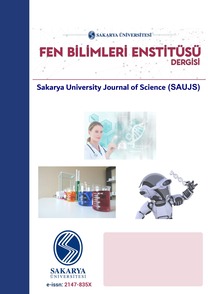Effect of The Filler Type and Particle Distribution Changes on Polyester Matrix Composites
___
Reference1 S. Ahmed and F.R. Jones, “A review of particulate reinforcement theories for polymer composites,” Journal of Materials Science, vol. 25, no. 12, pp. 4933-4942, 1990.Reference2 S. Kang, S. I. Hong, C. R. Choe, M. Park, S. Rim, and J. Kim, “Preparation and characterization of epoxy composites filled with functionalized nano silica particles obtained via sol-gel process,” Polymer, vol. 42, no. 3, pp. 879–887, 2001.
Reference3 S.S. Ray and M. Okamoto, “Polymer/layered silicate nanocomposites: a review from preparation to Processing,” Progress in Polymer Science, vol. 28, no. 11, pp.1539–1641, 2003.
Reference4 P. Singh, A. Kaushik, and Kirandeep, “Mechanical and transport properties of colloidal silica-unsaturated polyester composites,” Journal of Reinforced Plastics and Composites, vol. 25, no. 2, pp. 119-140, 2006.
Reference5 W.B. Fuller and S.E. Thompson, “The laws of proportioning concrete,” Trans. Amer. Soc. Civ. Engrs. Bd., vol. 59, no.67, 1907.
Reference6 A. Turkeli, http://mimoza.marmara.edu.tr/~altan.turkeli/files/cpt-2-sand_sand.pdf, (accessed 24/06/2019).
Reference7 MOLDING SAND, particle sizing for the foundry industry, https://www.retsch-technology.com/applications/technical-basics/molding-sand/ (accessed 24.12.2019).
Reference8 J. Jacobs and T. Kilduff, “Engineering materials technology: structures, processing, properties, and selection,” 2nd ed., Prentice-Hall, pp. 263-299, 1994.
Reference9 L. Horath, “Fundamentals of materials science for technologists: properties, testing and laboratory exercises,” 2nd ed., Prentice-Hall, pp. 100-133, 2001.
Reference10 S.H. Mansour and S.L. Abd-El-Messiah, “Electrical and mechanical properties of some polymeric composites,” Journal of Applied Polymer Science, vol. 83, no. 6, pp. 1167–1180, 2002.
Reference11 B.D. Agarwal, L.T. Broutman, and K. Chandrashekhara, “Analysis and performance of fibre composites,” 3rd ed., John Wiley, New York, 2006.
Reference12 H. Haddad and M. Al Kobaisi, “Influence of moisture content on the thermal and mechanical properties and curing behavior of polymeric matrix and polymer concrete composite,” Materials & Design, vol. 49, pp. 850-856, 2013.
Reference13 E. Ateş, and K. Aztekin, “Parçacık ve fiber takviyeli polimer kompozilerin yoğunluk ve basma dayanımı özellikleri,” Journal of the Faculty of Engineering & Architecture of Gazi University, vol. 26, no. 2, pp. 479–486, 2011.
Reference14 F. Mahdi, H. Abbas, and A.A. Khan, “Strength characteristics of polymer mortar and concrete using different compositions of resins derived from post-consumer PET bottles,” Construction and Building Materials, vol. 24, no. 1, pp. 25-36, 2010.
Reference15 E. Ateş and S. Barnes, “The effect of elevated temperature curing treatment on the compression strength of composites with polyester resin matrix and quartz filler,” Materials & Design, vol. 34, pp. 435-443, 2012.
Reference16 E. Ateş, “Optimization of compression strength by granulometry and change of binder rates in epoxy and polyester resin concrete,” Journal of Reinforced Plastics and Composites, vol. 28, no. 2, pp. 235-246, 2008.
Reference17 A. Akıncı, “Mechanical and morphological properties of basalt filled polymer matrix composites,” Archives of Materials Science and Engineering, vol. 35, no. 1, pp. 29-32, 2009.
Reference18 A.C. Moloney, H.H. Kausch, T. Kaiser, and H.R. Beer, “Parameters determining the strength and toughness of particulate filled epoxide resins,” Journal of Materials Science, vol. 22, no. 2, pp. 381-393, 1987.
Reference19 ASTM (2012) C579 – 01:Standard test methods for compressive strength of chemical-resistant mortars, grouts, monolithic surfacings, and polymer concretes. ASTM International, USA.
- ISSN: 1301-4048
- Yayın Aralığı: 6
- Başlangıç: 1997
- Yayıncı: Sakarya Üniversitesi Fen Bilimleri Enstitüsü
Corrosion Effects on Fatigue Behavior of Zn-Cr+3 and Zn Flake Coated M8 DIN 933 Bolts
Sezgin TURTDAŞ, Umut İNCE, Barış TANRIKULU, Cenk KILIÇASLAN, M. Burak TOPARLI
Damla AMUTKAN MUTLU, Irmak POLAT, Zekiye SULUDERE
Effect of The Filler Type and Particle Distribution Changes on Polyester Matrix Composites
A New Approach to k-Jacobsthal Lucas Sequences
Hakan AKKUŞ, Rabia Nagehan ÜREGEN, Engin ÖZKAN
Investigation of Origami Inspired Sub-6 GHz Accordion Monopole Antenna for 5G Applications
Duygu Nazan GENÇOĞLAN, Şule ÇOLAK
Voltage Stability Analysis of Large Scale PV Plant Reactive Power Control Methods
Bora ÇAVDAR, Ömür AKYAZI, Erdinc SAHIN, Fatih NUROGLU
Phytochemical and Bioactivity Analysis of Several Methanolic Extracts of Nine Bryophytes Species
Ebru K KOCAZORBAZ, Kerem TOK, Hichem MOULAHOUM, Rabia Nur ÜN
Green Supplier Selection Using Game Theory Based on Fuzzy SWARA
